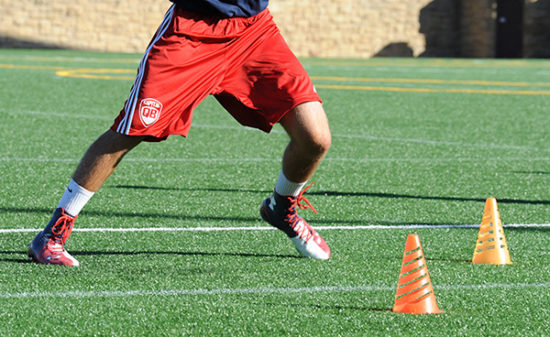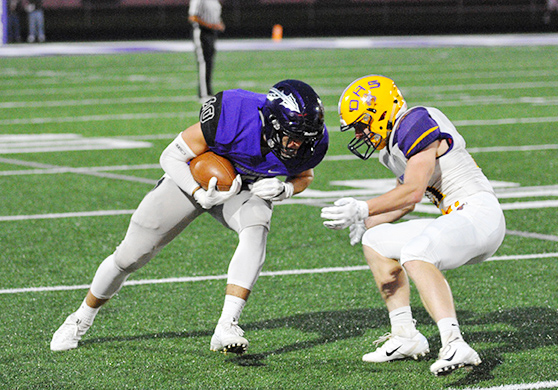The quarterback club
How Capital QB Academy is improving Wisconsin’s signal callers

A quarterback’s greatest asset is his arm, but playing the position starts with the feet.
That’s an idea that might sound counterintuitive to those not engrained in the game of football, but at Capital Quarterback Academy it’s a lesson that’s central to building dynamic athletes at the sport’s most valued position.“Quarterbacks have to have solid footwork to have a good arm,” said Shane Brossard, the academy’s founder and director. “People like old school Peyton Manning had really great feet. He couldn’t run downfield, but what he could do was move in the pocket two feet in any direction, and that ball was always on the money.”
Brossard has been a student of the position since the fourth grade. He played quarterback at Northern Michigan University and Division III powerhouse University of Wisconsin-Whitewater before opening Capital QB Academy in Madison, Wisconsin.
The academy was an avenue for Brossard to share what he had learned over the years. Coaching in high school or college was too time consuming, and this afforded him greater opportunities to work one-on-one with young quarterbacks.
Since the academy opened in 2010, Brossard estimates he has worked with a couple hundred athletes, improving their mechanics, accuracy and decision-making. His first year included just a handful of football players, but today he might work with as many as two dozen during a single summer.
“I thought it would be a shame to let all that knowledge go to waste,” Brossard said. “I decided to start it on a whim one summer just to see where it would go.”
QB evolution
The position has changed since Brossard’s playing days at DeForest High School (Wisconsin). He recalls participating in warm-ups during practices, but there were never drills designed to improve specific aspects of his game. But demands for the position have changed over the years, and he wanted Capital QB Academy to accommodate area signal callers.
 Mobility is in greater demand, and Brossard makes that a priority in his program. But there’s a difference between mobile quarterbacks and players like Mike Vick and Cam Newton.
Mobility is in greater demand, and Brossard makes that a priority in his program. But there’s a difference between mobile quarterbacks and players like Mike Vick and Cam Newton.
The running quarterbacks who found success in the NFL are gifted athletes, but being a mobile quarterback doesn’t require downfield running. It’s about movement in the pocket, focus and accuracy.
Brossard estimates that 60 percent of the drills run during a typical session focus on footwork. He wants quarterbacks to develop the ability to keep their eyes downfield, avoid pressure in the pocket and make accurate passes. Without solid footwork, they tend to panic and deliver errant throws.
“We throw a lot of different drills at them to make them move side to side,” Brossard said. One drill requires tossing beanbags at a quarterback, forcing him to react appropriately. Meanwhile, he must look for an open receiver while calling out the number of fingers held up by another coach.
“There’s a lot that comes at you, and you have to stay focused and not let your technique break down,” he added. “That happens a lot when someone breaks through the line or you get bumped.”
It’s all about creating what Brossard calls “dual-purpose quarterbacks” — different from dual threat. Some quarterbacks can throw on the run but are uncomfortable in the pocket, while others lose their accuracy when a defense forces them to fade toward the sideline.
Matt Kimmes, a running backs coach at La Follette High School, joined Capital QB Academy after its first year, acting as “another pair of eyes” to study players and offer input. He helps quarterbacks adjust and attack certain types of schemes they might encounter on defense.
He said the evolution of the position is especially noticeable in the Madison area, where passing offenses are among the state’s best. Like Brossard, he recognizes an emphasis on mobility but added that Capital QB Academy develops all-around football players.
“There are some things we look at to find what they struggle with or why a bad decision was made,” Kimmes said.
The academy
Capital QB Academy welcomes football players from youth to the high school level, but Brossard prefers to work with them as early as possible. That allows him to develop good habits and instill the basics of playing the position — the quarterback-center exchange, three- and five-step drops, ball-grip mechanics.
 The biggest obstacle for quarterbacks is being comfortable throwing from the pocket. Brossard said a lot of quarterbacks are accustomed to taking a five-step drop and hitting a receiver on the run — something they’ve done hundreds of times on the playground — but the moment you put bodies in front of them and create disorder, they clam up and deviate from the fundamentals. That’s why he uses so many drills that challenge quarterbacks mentally.
The biggest obstacle for quarterbacks is being comfortable throwing from the pocket. Brossard said a lot of quarterbacks are accustomed to taking a five-step drop and hitting a receiver on the run — something they’ve done hundreds of times on the playground — but the moment you put bodies in front of them and create disorder, they clam up and deviate from the fundamentals. That’s why he uses so many drills that challenge quarterbacks mentally.
It’s not easy, and while some young athletes may not be suited for the position, Brossard isn’t willing to give up on them. Many quarterbacks have trouble reading defenses and hitting receivers in stride, but those problems can be overcome.
“We do work with kids in growing at that capacity, we challenge them,” Brossard said. “With some, it’s like a kid standing at the math board but they can’t solve the problem.”
That’s where Brossard feels like Capital QB Academy offers a unique learning experience. Like most athletes, he attended camps as a young football player. They teach valuable lessons and improve individual skills, but most camps only last a couple days — not nearly enough time to learn such a complex position.
Capital QB Academy works with quarterbacks for up to eight weeks during the summer. Student-athletes who don’t participate in multiple sports (there aren’t many) might come back during the winter after the football season is over, and a few might even come in during the spring.
Kimmes said the academy’s small size gives it an advantage. Four coaches mentor no more than two dozen players, so they’re able to spend more one-on-one time instructing athlete individually. The academy embraces its role in progressing athletes throughout their careers, as opposed to handing out advice and sending players on their way.
“Shane calls it an academy for a reason,” Kimmes said. “We’re not just meeting one weekend out of the year, trying to cram as much information as we can into a three-hour session. In a one-day type of atmosphere, I don’t know how much work you can get done.”
It’s a long process, but one that Brossard is fully invested in. Youth team coaches or private instructors might spend just a short time with the athletes, but Brossard and his Capital QB Academy want to be more than that.
“What I try to do is be part of their journey,” Brossard said. “I always tell them it’s like open gym every week, and you do that and get better and better. This is like an open gym for football, but there is structure to it.
“I want to be part of their growth, not just over one summer. Hopefully, it’s multiple summers and multiple years.”





